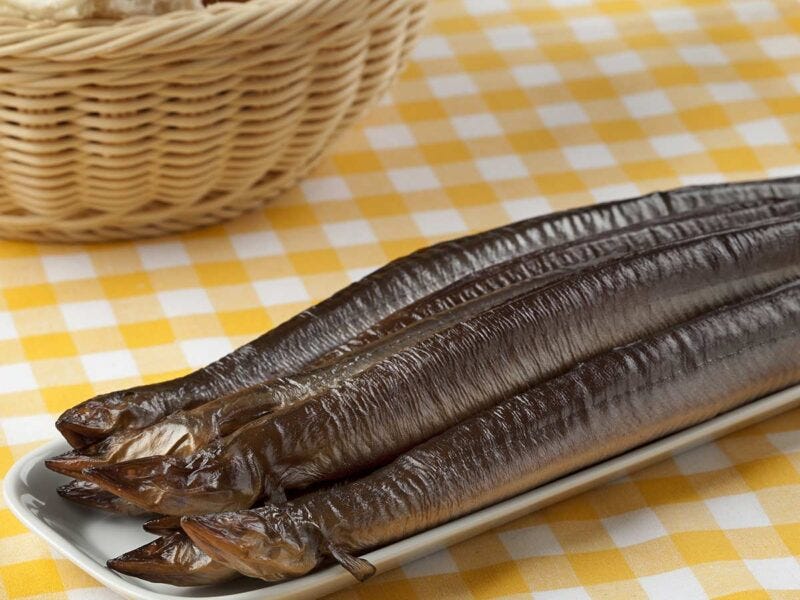Eel is a type of fish that has a long, snake-like body and no scales. It is often used in some cuisines, especially in Asian dishes like sushi and unagi. But can dogs eat eel? Is it safe and healthy for them?
The answer is not so simple. Eel can be both beneficial and harmful for dogs, depending on how it is prepared and how much is consumed.
In this article, we will explore the pros and cons of feeding eel to your dog, and what precautions you need to take to avoid any potential risks.
Contents
Can Dogs Eat Eel? Benefits and Risks of Eel for Dogs
Benefits of Eel for Dogs
Eel, when cooked properly, can provide some nutritional benefits for dogs. It has a lot of protein, minerals, vitamins, and omega-3 fatty acids. These nutrients can support your dog’s immune system, heart health, skin and coat condition, and brain function.
Some of the specific nutrients that eel contains are:
- Vitamin A: This vitamin is essential for your dog’s vision, growth, reproduction, and immune system. It also helps prevent dry eyes, night blindness, and infections.
- Vitamin B1 (Thiamine): This vitamin helps your dog’s body convert food into energy. It also supports the nervous system, the heart, and the muscles.
- Vitamin B2 (Riboflavin): This vitamin helps your dog’s body break down fats, proteins, and carbohydrates. It also promotes healthy skin, eyes, and coat.
- Vitamin B12 (Cobalamin): This vitamin is vital for your dog’s DNA synthesis, red blood cell production, and nerve function. It also helps prevent anemia, neurological disorders, and digestive problems.
- Vitamin D: This vitamin helps your dog’s body absorb calcium and phosphorus, which are important for bone and teeth health. It also regulates the immune system, the nervous system, and the muscles.
- Vitamin E: This vitamin is a powerful antioxidant that protects your dog’s cells from free radical damage. It also helps prevent inflammation, infections, and chronic diseases.
- Phosphorus: This mineral works with calcium to maintain your dog’s bone and teeth health. It also helps the body use energy, synthesize proteins, and balance the pH levels.
- Omega-3 fatty acids: These fatty acids are essential for your dog’s brain development, cognitive function, and behavior. They also reduce inflammation, lower blood pressure, and improve skin and coat health.
Risks of Eel for Dogs
Eel, when raw or improperly cooked, can pose some serious health risks for dogs. This is because eel blood contains a toxic protein that can damage your dog’s nervous system, including the heart and the brain. This protein can be destroyed by cooking, but not by freezing or salting.

Another risk of eel is ciguatera poisoning, which is caused by eating certain types of reef fish that have accumulated toxins from algae. Eel is one of the fish that can carry this toxin, which can cause nausea, vomiting, diarrhea, stomach pain, itching, and neurological symptoms in dogs.
To avoid these risks, you need to make sure that any eel you feed to your dog is cleaned, skinned, deboned, and cooked thoroughly. You also need to limit the amount and frequency of eel consumption, as it can be high in mercury and cholesterol, which can harm your dog’s liver and kidneys.
Suggested: Can Dogs Eat Sun Chips?
Can Dogs Have Cream Cheese Icing?
How to Feed Eel to Your Dog
If you decide to feed eel to your dog, here are some tips to follow:
- Choose fresh or frozen eel that has been properly cleaned, skinned, and deboned. Avoid canned, smoked, or salted eel, as they may contain preservatives, additives, or excess sodium.
- Cook the eel in the oven or on the stove, without any seasonings, oils, or sauces. The internal temperature of the eel should reach at least 145°F to kill any bacteria or parasites.
- Cut the eel into small pieces that are easy for your dog to chew and swallow. Remove any bones or skin that may be left.
- Feed the eel as an occasional treat, not as a regular part of your dog’s diet. A small amount of eel once or twice a week is enough for most dogs. Consult your vet for the appropriate portion size for your dog, based on their weight, age, and health condition.
- Monitor your dog for any signs of allergic reaction, intolerance, or poisoning after eating eel. If you notice any symptoms such as vomiting, diarrhea, lethargy, itching, or seizures, stop feeding the eel and contact your vet immediately.
How do I prepare eel for my dog?
To prepare eel for your dog, you need to follow these steps:
- Choose fresh or frozen eel that has been properly cleaned, skinned, and deboned. Avoid canned, smoked, or salted eel, as they may contain preservatives, additives, or excess sodium.
- Cook the eel in the oven or on the stove, without any seasonings, oils, or sauces. The internal temperature of the eel should reach at least 145°F to kill any bacteria or parasites.
- Cut the eel into small pieces that are easy for your dog to chew and swallow. Remove any bones or skin that may be left.
- Feed the eel as an occasional treat, not as a regular part of your dog’s diet. A small amount of eel once or twice a week is enough for most dogs. Consult your vet for the appropriate portion size for your dog, based on their weight, age, and health condition.
- Monitor your dog for any signs of allergic reaction, intolerance, or poisoning after eating eel. If you notice any symptoms such as vomiting, diarrhea, lethargy, itching, or seizures, stop feeding the eel and contact your vet immediately.

Is cooked eel safe to eat?
Cooked eel is safe to eat for humans and dogs, as long as it is prepared properly and consumed in moderation. Cooking eel can destroy the toxic protein in its blood that can cause neurological damage, as well as kill any bacteria or parasites that may be present.
However, cooked eel can still be high in mercury and cholesterol, which can harm the liver and kidneys if eaten too frequently or in large amounts. Therefore, it is advisable to limit the intake of cooked eel to once or twice a week and choose fresh or frozen eel that has been cleaned, skinned, and deboned.
Can dogs eat eel sushi?
Dogs should not eat eel sushi, as it can pose serious health risks for them. Eel sushi is made with raw or lightly cooked eel, which can contain a toxic protein in its blood that can damage the nervous system of dogs, including the heart and the brain.
Eel sushi can also carry parasites, bacteria, or toxins that can cause gastrointestinal or neurological problems in dogs.
Moreover, eel sushi is often seasoned with soy sauce, sugar, vinegar, or other ingredients that can be harmful to dogs, such as salt, garlic, or onion. Therefore, it is best to avoid feeding eel sushi to your dog and opt for cooked eel instead.
Is eel sauce OK for dogs?
Eel sauce is not OK for dogs, as it can contain ingredients that can be toxic or unhealthy for them. Eel sauce is a thick, sweet, and savory sauce that is used to flavor eel dishes, especially in Japanese cuisine.
Usually, soy sauce, sugar, mirin, and sake are used to make it. These ingredients can be harmful to dogs, as they can cause high blood pressure, dehydration, obesity, diabetes, or liver damage.
Eel sauce can also contain garlic or onion, which can cause hemolytic anemia in dogs. Therefore, it is recommended to avoid giving eel sauce to your dog and stick to plain, cooked eel instead.
Conclusion
Eel can be a tasty and nutritious treat for dogs, as long as it is prepared correctly and fed in moderation. Can dogs eat eel? Eel can provide your dog with protein, omega-3 fatty acids, vitamins, and minerals that can benefit their health.
However, eel can also be dangerous for dogs, as it can contain toxic blood, parasites, mercury, and cholesterol that can harm their nervous system, digestive system, liver, and kidneys.
Therefore, you need to be careful when feeding eel to your dog, and always consult your vet before introducing any new food to your dog’s diet.
FAQs: Can dogs eat eel?
Q: Is eel safe for dogs to eat?
- A: Eel can be safe for dogs to eat, but only if it is cleaned, skinned, deboned, and cooked thoroughly. Raw or improperly cooked eel can contain toxic blood, parasites, or toxins that can harm your dog’s nervous system, digestive system, liver, or kidneys. Therefore, you need to be careful when feeding eel to your dog, and always consult your vet before introducing any new food to your dog’s diet.
Q: What are the benefits of eel for dogs?
- A: Eel, when cooked properly, can provide some nutritional benefits for dogs. It has a lot of protein, minerals, vitamins, and omega-3 fatty acids. These nutrients can help your dog’s heart health, immune system, skin and coat quality, and cognitive performance. However, eel should only be fed to dogs as an occasional treat, not as a regular part of their diet, as it can also be high in mercury and cholesterol, which can harm your dog’s liver and kidneys.
Q: How many eels can I feed to my dog?
- A: The amount of eel you can feed to your dog depends on several factors, such as your dog’s weight, age, health condition, and dietary needs. A general rule of thumb is to feed no more than 10% of your dog’s daily calories from treats, including eel. A small amount of eel once or twice a week is enough for most dogs. You can consult your vet for the appropriate portion size for your dog, based on their individual needs.
Q: Can dogs eat eel sushi or eel sauce?
- A: No, dogs should not eat eel sushi or eel sauce, as they can pose serious health risks for them. Eel sushi is made with raw or lightly cooked eel, which can contain toxic blood, parasites, or toxins that can harm your dog. Eel sauce is a thick, sweet, and savory sauce that is made with soy sauce, sugar, mirin, and sake. These ingredients can be harmful to dogs, as they can cause high blood pressure, dehydration, obesity, diabetes, or liver damage. Eel sauce can also contain garlic or onion, which can cause hemolytic anemia in dogs. Therefore, it is best to avoid feeding eel sushi or eel sauce to your dog and stick to plain, cooked eel instead.
Q: How do I prepare eel for my dog?
- A: To prepare eel for your dog, you need to follow these steps:
- Choose fresh or frozen eel that has been properly cleaned, skinned, and deboned. Avoid canned, smoked, or salted eel, as they may contain preservatives, additives, or excess sodium.
- Cook the eel in the oven or on the stove, without any seasonings, oils, or sauces. The internal temperature of the eel should reach at least 145°F to kill any bacteria or parasites.
- Cut the eel into small pieces that are easy for your dog to chew and swallow. Remove any bones or skin that may be left.
- Feed the eel as an occasional treat, not as a regular part of your dog’s diet. A small amount of eel once or twice a week is enough for most dogs. Consult your vet for the appropriate portion size for your dog, based on their weight, age, and health condition.
- Monitor your dog for any signs of allergic reaction, intolerance, or poisoning after eating eel. If you notice any symptoms such as vomiting, diarrhea, lethargy, itching, or seizures, stop feeding the eel and contact your vet immediately.




